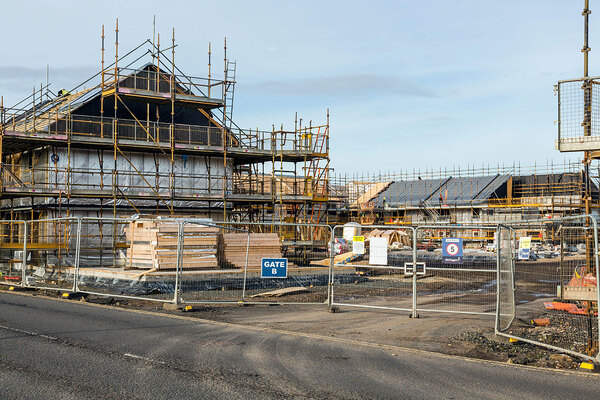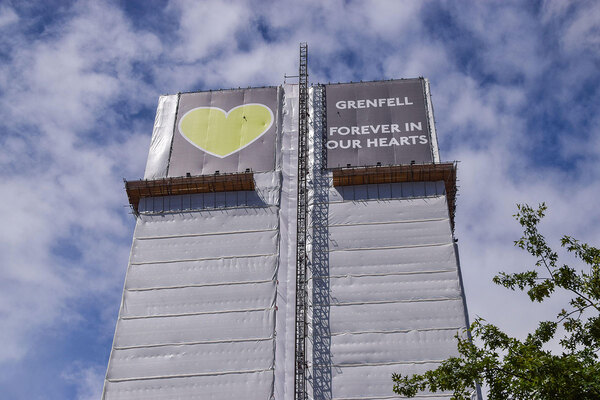What steps should landlords be taking on the golden thread?
Caroline Thorpe looks at how social landlords are approaching the challenge of creating a ‘golden thread’ of information about their tall buildings. Illustration by Sam Chivers
We’ve all been there: wading through papers, quizzing colleagues for the whereabouts of a USB drive, or manically hitting CTRL-F to uncover that elusive nugget of information. It’s frustrating. But when it comes to building safety, where residents’ well-being depends on many thousands of pieces of information being present and correct – from cladding type to the location of fire doors – poor data management can be outright dangerous.
“Government is encouraging building owners of really any height to start looking at your buildings now”
It is this reality that prompted Dame Judith Hackitt – in the wake of the 2017 Grenfell disaster, where a lack of information about the building’s make-up contributed to 72 deaths – to advocate a “golden thread” of data, a consistently updated digital record for each and every tall building. The concept is embedded in the Building Safety Bill, which will be introduced to Parliament later this year. A new Building Safety Regulator will police the new statutory requirements in England and Wales.
There were an estimated 12,500 high-rise residential blocks of at least 18 metres at the last count in April 2020, 6,000 of them in the social sector. So for social landlords, implementing the golden thread is an enormous task – and what does the sector need to do?
Understanding the golden thread is the obvious place to start. In April, the UK government defined the concept as “the information that allows you to understand a building and the steps needed to keep both the building and people safe, now and in the future”. Dame Judith’s Building a Safer Future report suggests that this includes everything from a block’s size to what it is made of and the location of fire escapes (see box: What information makes up a golden thread?).
Although it will initially apply to the tallest buildings, ultimately blocks of less than 18 metres are expected to fall under its remit. “Government is encouraging building owners of really any height to start looking at your buildings now,” says Kathryn Kligerman, a partner at law firm Devonshires. This month’s fire at a 559-home east London development, owned by Ballymore, underlines the urgency of the task.
Landlords must identify which stock the golden thread applies to, gather the required data, standardise it in a digital format, keep it updated and make it widely available, including to residents.
Doing so is inevitably complex: existing and new blocks require different processes; landlords are facing a mix of often untried approaches to gathering their golden threads; and for many organisations lack of skills and resources present further challenges.
“Having that information in a standardised way makes it possible to place it, for example, in a premise’s [fire information] box or [send it] electronically to the fire service”
For new high-rise developments, the golden thread will form the backbone of the incoming regime, which will require the building owner to demonstrate compliance at each of three ‘gateways’: during planning, prior to construction beginning and before occupation. An incomplete golden thread at any stage will prevent progress to the next.
Jack Ostrofsky, quality and design head at Southern Housing Group, echoes Ms Kligerman when he says landlords with tower blocks at any stage of development should act now. Speaking as chair of BIM4 Housing Associations, a cross-industry body assessing approaches to the golden thread, Mr Ostrofsky advocates two starting points for developing landlords.
The first is using Building Information Modelling (BIM) methods, widely used across the construction industry but not always familiar in housing. Mr Ostrofsky’s group has adapted BIM for social landlords, calculating “how we would apply BIM for new development contracts”. He explains that writing BIM into contracts ensures all those working on the project, such as architects and contractors, will need to present information relating to the project in a standardised and digitally transferrable format – specifying whether measurements should be written “width/height/length” or otherwise, for example.
“This lays the foundations of the golden thread,” he says, adding that Southern has tested it in nine development contracts to date and plans to use it universally from now on. “Having that information in a standardised way makes it possible to place it, for example, in a premise’s [fire information] box or [send it] electronically to the fire service.”
“A development can be an accumulation of thousands of decisions over two or three years. It’s about making sure that when you’re making the key building safety decisions that you record what you’re doing”
Mr Ostrofsky’s second tip is to adopt UK Housing Data Standards – a package developed by housing innovation charity HACT in collaboration with the sector which standardises data, making it consistent and easily shared.
Jacqui Bateson, managing director at HACT, concurs: “The golden thread will stand and fall with the UK Housing Data Standards; it’s a great place to start… [the] standards are there and are free. It is within organisations’ gift to move forward with this.”
Some landlords have been testing their own approaches. David Stronge, assistant director for design and technical at Peabody, is working on its golden thread. Data ownership is key, he says. “At the moment… data moves between systems depending on the stage of the project you’re at. For example, in the early design stages maybe the architects hold it.” When moved, data can be summarised, erasing key details, or lost entirely. “I need to own and see that information and how it’s shared from the very start,” says Mr Stronge.
Peabody’s internal ‘Gateway’ project is piloting a web-based system to track data management, governance and decision-making on two new schemes. This includes detailed building photographs and drawings. “A development can be an accumulation of thousands of decisions over two or three years. It’s about making sure that when you’re making the key building safety decisions that you record what you’re doing.” The hope is to roll the project out later this year.
What information makes up a golden thread?*
New buildings
- Building size and height
- Structure
- Fabric
- Fire escape and compartmentation detail
- Permanent fixtures and fittings
Existing buildings
- Building size and height
- Full material and manufacturer product detail
- All safety-critical layers of protection
- Digital data capture of completed buildings, eg via laser scanning
- Inspection reports
Source: Building a Safer Future final report; *non-exhaustive list
Landlords running golden thread pilots for existing stock include WHG and Clarion. Both have created visual golden threads – digital representations of high-rise blocks that allow users to click on components such as walls, cladding or lifts, to access full information on their make-up and history. Crucially, they can be updated in real time when elements of the building change.
For Jack White, technical manager at Clarion, this approach meets the golden thread requirement of current, dynamic data. “It tells us: what did the building look like yesterday?”
To create these digital records, buildings are scanned to produce 3D digital models. Mr White and his asset management colleagues trialled laser scanners.
“Architects would advise us to try one thing, but in the end we found what worked for us was using a cheaper but quicker scanner that didn’t require us to spend 45 minutes scanning someone’s flat,” he says.
Clarion has also overhauled the level of detail it keeps on each building, for example breaking buildings and their information into smaller parts to help the fire service locate the correct access point in an emergency. “Now we are trying to develop an app to standardise the data,” Mr White adds.
“If you set it up as we have and are doing a lot of work internally, it’s not particularly expensive. If you were to do this primarily through a consultant, then it could be”
What of the cost? “If you set it up as we have and are doing a lot of work internally, it’s not particularly expensive. If you were to do this primarily through a consultant, then it could be,” he says.
Organisations lacking the skills, staffing and funding to implement the golden thread should not despair. Ms Kligerman points to a wealth of free working groups and resources available to the sector, such as the Building Regulations Advisory Committee (BRAC), where golden thread information and approaches are shared and discussed, and the government’s Golden Thread Initiative.
Meanwhile, BIM4 Housing Associations plans to publish “a toolkit to use in the typical housing association design and build context”, says Mr Ostrofsky, following peer review.
Despite the scale of the challenge, the ultimate purpose of the golden thread is reminder enough of its importance. As Paul Dockerill, director of energy and programme management at WHG, puts it: “It’s that information available to the fire service at 3am when they can see there’s a building with new cladding and they’re asking, ‘Why is it burning so quickly?’”
Update: at 11am on 9.6.2021
An earlier draft of this artcle said the Building Safety Bill had passed through Parliament when it has not yet been introduced. This has been corrected.
WHG – a case study
“We went down the CSI: Miami-type route,” says Paul Dockerill.
The director of energy and programme management at 21,000-home landlord WHG is explaining how his organisation has gone high-tech in establishing its golden threads, initially for 17 high-rise and five over-55s blocks.
“They will be able to click on an app and all that [golden thread] information they need about the number of floors, hydrants, occupation and so on, they have that on the way to the building. They can be assessing that on the way [to an emergency]”
In June, WHG will test the system with West Midlands Fire Service. “They will be able to click on an app and all that [golden thread] information they need about the number of floors, hydrants, occupation and so on, they have that on the way to the building. They can be assessing that on the way [to an emergency].”
Residents will have access to the digital version of their building, via an app, and some have already donned goggles and enjoyed a virtual reality tour. “They loved it,” says Mr Dockerill. “For customers it’s been comforting.”
But, he adds, old-fashioned shoe leather sits alongside the tech. Twice yearly, staff tour the blocks to gather real-life intelligence. “We'll be told about the guy who props the fire door open with a car battery… and we can manage that.”
WHG worked with software developer Deeo to design its golden thread app. Mr Dockerill estimates it has cost £200-£300 per flat. “What we’ve done sounds like an expensive option. But you’ve got to modernise, otherwise you’ll end up with loads of spreadsheets that you’ve got to trail through.”
Having developed the app, the landlord is now sharing it with other landlords, at cost. “Ten housing providers have procured it and another 23 are procuring it… We’re really confident about what it does. There is no commercial gain for WHG – there is a moral aspect to it.”
For those yet to tackle the golden thread, Mr Dockerill has the following advice: “Start with a mapping process – understanding what information you have will be important. The National Housing Federation, MHCLG and every fire and rescue service has working groups where local people can come and learn about fire safety and work together. Educate yourself in the first instance. There’s no excuse to say, ‘I don’t know what’s out there.’”
Sign up to our Development Summit
Amid the housing crisis and with increasing demands on local authorities, developers and housing associations to deliver more homes, the Inside Housing and Homes England Development Summit brings together the public and private sector to collaborate towards the effective delivery of homes across England.
This is not a conference. It is a business meeting of decision-makers on delivery and how to build more quality homes.
To find out more, click here.










